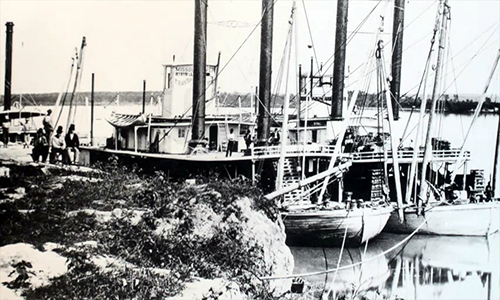(Columbia Missourian) – Malta Bend, Missouri – Wet, thick mud oozed out of the ground as a drilling rig spiraled in and out of the rich bottom land 1,000 feet from the Missouri River. The drill cranked 37 feet down. Each time it came up, workers moved the portable rig another foot, later refilling the holes left behind and marking them with white paint.
This paint forms an outline in the farm field, a rectangular shape 140 feet long by 22 feet wide. The rig stopped Saturday afternoon as it rounded out the last corner, affirming David Hawley’s suspicion of what it had been running into down below.
The outline marks the underground location of the steamboat Malta — the town’s namesake. There is a mural dedicated to the boat in the center of this small town on Highway 65 west of Marshall, and a sign at City Hall depicts a smaller version.
Hawley has been searching for steamboat wrecks up and down the Missouri River for more than 30 years. He’s found 11 and dug up two, including the steamboat Arabia near Kansas City in 1987.
The Arabia produced a vast collection of preserved trade goods from 1856 that are on display at the Arabia Steamboat Museum.
The Malta is Hawley’s latest find. In February, a core sample unearthed black and red wool and window glass, Hawley said, but more samples need to be taken to better determine what the Malta holds.
“If we find beads or pipes, we’re off to the races,” he said.
Whatever the team finds inside, Hawley said he’d like to combine its artifacts with those at the Arabia museum.
“It could be the museum of the great American steamboat,” Hawley said.
The Malta sank in the Missouri River in 1841. The boat, built in Pittsburgh in 1839, had left St. Louis for Council Bluffs, Iowa. Only until the Malta reveals its cargo will Hawley know whether the boat was headed upriver laden with fabrics, food and household goods or hauling furs for the American Fur Co. in St. Louis.
Hawley had known about the Malta for years, but he waited to start searching until 2014. He knew the Malta sank near the town of Malta Bend because of the name and turned to newspaper archives to narrow down its location.
He learned the dimensions of the boat — 140 feet long by 22 feet wide — measurements confirmed by the drilling on Saturday, are an exact match for the object under the field.
The newspapers said the Malta had gone down about two miles from Laynesville, a small town a few miles north of Malta Bend that has since disappeared as the Missouri River changed course.
Hawley said he compared maps of the Malta Bend area over time before he “just started looking.” He drew a grid to go along with a present-day map to track miles of walking with a metal detector.
“It’s like mowing a lawn, you go back and forth,” Hawley said. “When you get your lawn cut, you can see where you’ve been before.”
Around this time last year, his metal detector found high concentrations of metal in a field owned by farmer Jim Backes. Hawley wondered if it was the Malta.
Backes grew up on the farm and has lived in Malta Bend for much of his life. He said there had been speculation for years that the boat was somewhere in the area, but was surprised to learn it was on his land.
“We had no idea it was right there,” Backes said. “It’s real exciting.”
Indications of a metal mass gave Hawley a clue. The locations of the metal, he said, aligned with the layout of a 19th century steamboat, with the highest concentrations in spots where an engine, boiler and paddle wheels would be.
Hawley then decided to ask friends in construction and archaeology businesses for help verifying what’s underground. Drilling at the site began in January.
Hawley said when the team first began, they moved the drill at 10- to 15-foot intervals, but as the outline neared completion, the drilling became more precise at about a foot between each hole. Drilling can’t be done every day; the process is dependent on weather and dry soil.
Spots along the outline of “hits” are marked with red flags; misses are marked with white flags. The places with high levels of metal are circled within the outline in orange paint.
“It’s like playing Battleship,” Hawley said. “You hit and you miss.”
Hawley’s father owned a heating and cooling business, and in 1985 Hawley met a customer who “looked for steamboats, flying saucers and Bigfoot.”
“I didn’t care about flying saucers or Bigfoot,” he said. “But I wanted to know about steamboats.”
So he read up on the Missouri River’s lost steamboats, trying to learn all he could about where and when they sank. That same year, he found his first boat, the Missouri Packet, whose engine is now at the museum. Two years later, he would find the Arabia.
He can’t do this work alone working with construction companies and archaeologists since beginning the search for the Malta.
“It’s like the end of a movie where you have all the credits,” Hawley said. “We’re bringing in good people to the project.”
Kansas City archaeologist John Fulmer was at the site when the drilling to outline the boat was finished on Saturday and was excited that the measurements matched those of the Malta.
“Dave had a hypothesis about this boat and pretty good records,” Fulmer said. “It all came out with what we were hoping for.”
“Everything today supported his hypothesis,” he said.
Hawley has big dreams for the Malta and for future steamboat finds. He doesn’t work in the family business anymore; the museum and searching for steamboats are his full-time gigs.
Before Hawley’s vision of a “great American steamboat museum” becomes a reality, he has to decide whether to take the risk of excavating the Malta.
Backes has given Hawley’s team permission to dig up the boat, but excavation cannot start until this year’s corn crops have been harvested.
Hawley said he and his family borrowed almost $1 million to pay for equipment to dig up the Arabia. The collection in the Arabia was so vast that 25 years after the museum opened, artifacts are still being cleaned and restored; Hawley said revenue from ticket sales goes back into these efforts.
Digging up another boat, especially not knowing what is inside, is high-risk, he said.
If the Malta is excavated, it’ll be in the winter. Cold air preserves artifacts better than warm air, Hawley said.
At some point, Fulmer said, if the decision is made to excavate the boat, the project will need a permit from the state . A professional may be needed to evaluate the project, and Fulmer has offered his services.
It’ll be a lot of work, and a lot of money, but to Hawley the prospects are bright. After all, they’ve gotten lucky so far.
“We’re doing a lot more right than we are wrong,” he said.
Article by Cecilia Salomone. She is a master’s student at the Missouri School of Journalism and a reporter for the Enterprise beat for spring 2016, and can be reached at [email protected]







